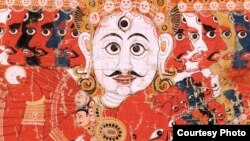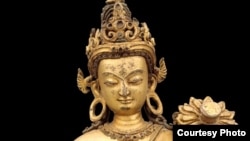When a 7.8 magnitude earthquake struck Nepal on April 25, world attention focused largely on the Himalayan country, where over 7,500 Nepalis were killed and untold numbers were injured or made homeless.
While international relief efforts took many forms, in New York, the Rubin Museum of Art, a major Himalayan arts center, began working to raise awareness of Nepal's cultural heritage and its ongoing plight.
Located some 12,000 kilometers away from Nepal, Executive Director Patrick Sears says the Rubin bridges the gulf by showcasing Himalayan arts and ideas, and the region's ties to other cultures.
"We are far away but we're also very close," he says.
Connected 'under the skin'
Like New York, Nepal is a melting pot of ethnic and religious groups. Sherpas, Ghurkas, Newaris, Hindus, Buddhists and others call it home.
"It's a place where religious expression and philosophical expression has combined and melded in a very interesting way," Sears notes. "It still guides the principles of Nepalese who use [religious] objects [and texts] for veneration, for study, for inspiration, and just to be surrounded in their lives with them."
Among Westerners, religion is often separate from daily life. In contrast, ordinary life for most Nepalis is steeped in spirituality and ritual: sacred Nepali sites and monuments are believed to play a crucial role in the health and happiness of its citizens.
"And when those sites and monuments are damaged or lost, it's felt in a different way there than it would be here," says Sears. "It is a vibrant culture, and it is, unfortunately, a largely impoverished one — one in which communication is challenging, and one in which the governments are also challenged for both political and economic reasons.
"The Nepalese have very little," he adds. "But it is also a resilient, optimistic culture."
Years of restoration damaged
Museum specialists have spent years getting to know the people of Nepal and their art, religion, history and culture; many have worked extensively with the U.N. and various NGOs in the Kathmandu Valley to help restore some of Nepal's architectural treasures.
When the earthquake hit, it destroyed or damaged decades of careful work.
For Jan Van Alphen, the Rubin Museum's Director of Exhibitions, Collections and Research, who often took the lead in those efforts, the quake was personal in another way: his daughter worked in a Kathmandu orphanage whose roof collapsed. Fortunately, all the children survived.
"My daughter had contact with the children in the school over there recently and they are all smiling," he said. "Not that they are happy with the situation, but they adapt very quickly."
For the 90 percent of the Nepalese who live outside the Katmandu Valley, Van Alphen adds, life remains hard.
"And they deal with it. They deal with the spirits. They deal with the mountains and with many problems of infrastructure," he says. "They are survivors, for sure.
"Despite the damage they have now, they will go on," he adds. "An earthquake is not enough to finish with all that."
'Honoring Nepal' through aid
The Rubin Museum is in a delicate position with respect to the current crisis. On the one hand, the Rubin is not a charitable fundraising organization; on the other hand, it is a natural "go-to" place for Americans who want to know how to help in the quake's aftermath. So Sears and his staff named a section of their website "Honoring Nepal," which is divided into various information-gathering and sharing portals.
"Knowing where to give in a time of real tragedy is a very challenging thing, especially if you are not familiar with the region," says Sears. "We can help by vetting a number of charities that work in the region that are on the ground now that are trying to be of immediate, medium and longer-term assistance. We hope that that section provides a little bit of information and help to those seeking to give in some tangible way."
Because the intense media attention on the earthquake has made the public aware of Nepal in a way it rarely has been before, Rubin curators are also displaying a range of fascinating Nepali artifacts, both on the website and in a small exhibition space in the museum.
Sears hopes that people in the U.S. and around the world will engage with the Nepali artifacts online and perhaps come to the museum to see "a small, very quick selection that we've placed on view, [hopefully] be inspired them, and reflect not only on the history but also on the current circumstances."














